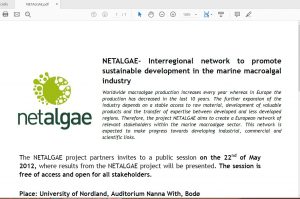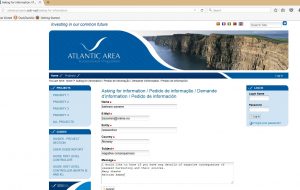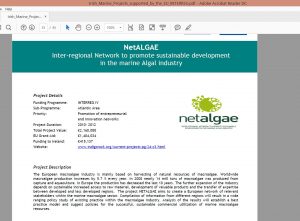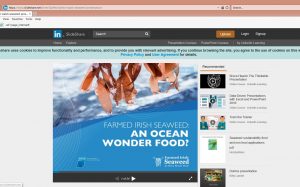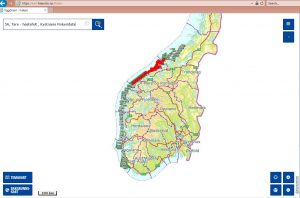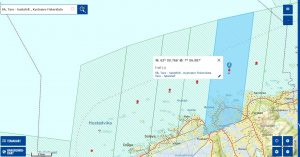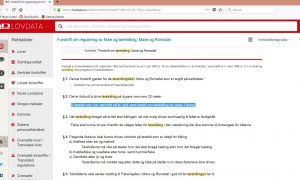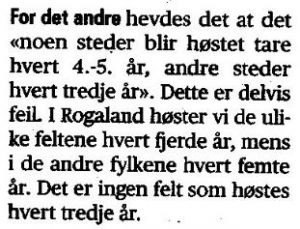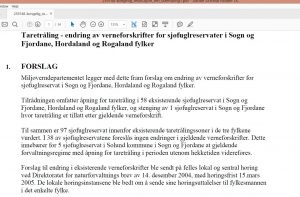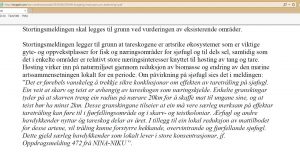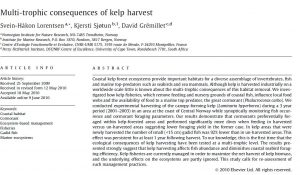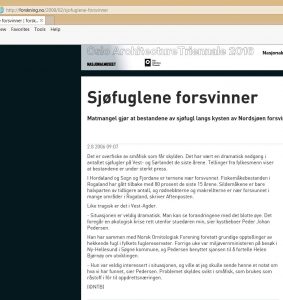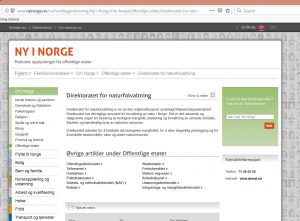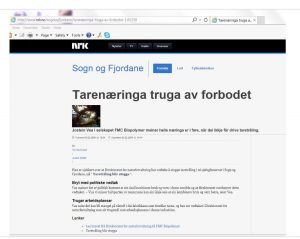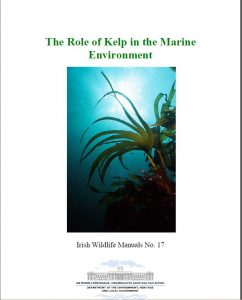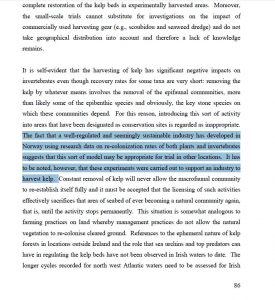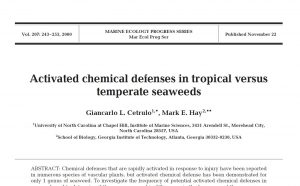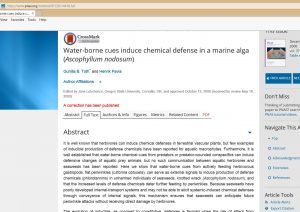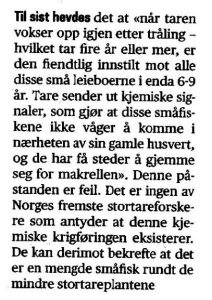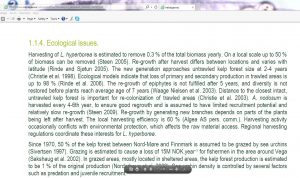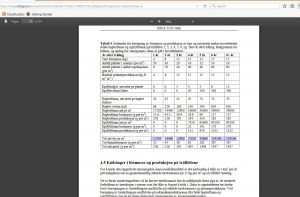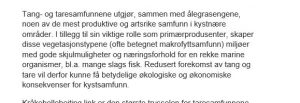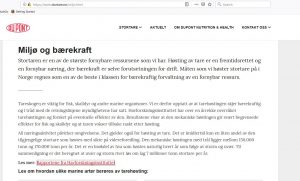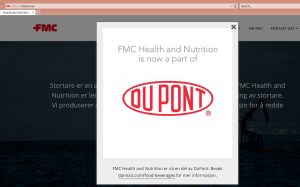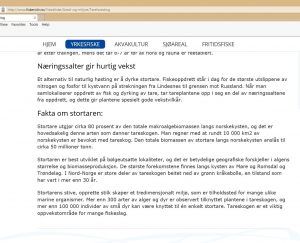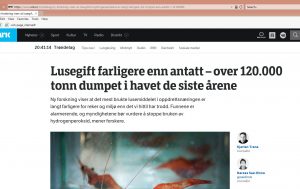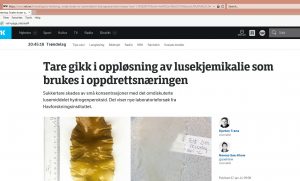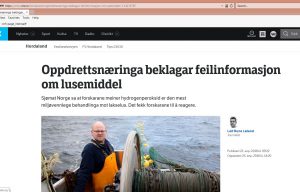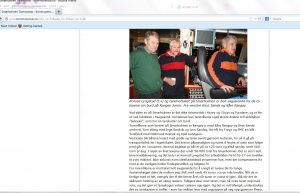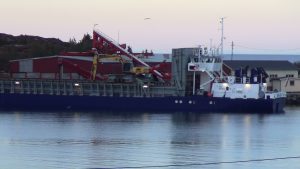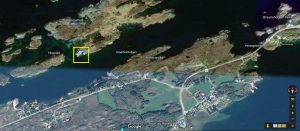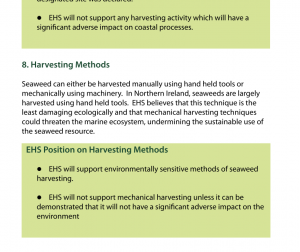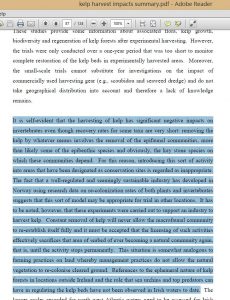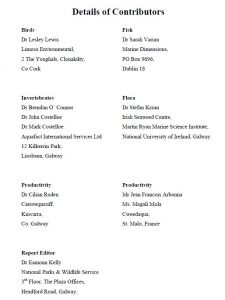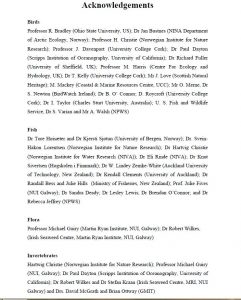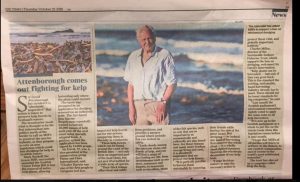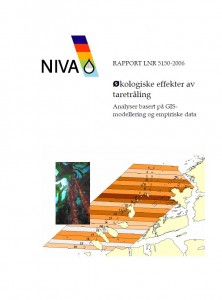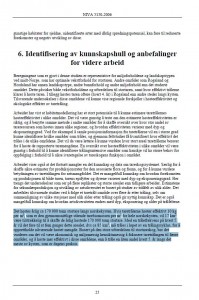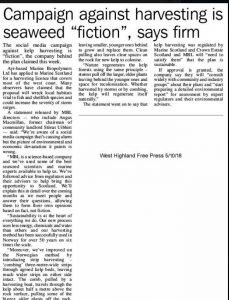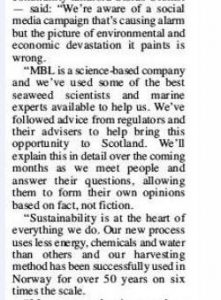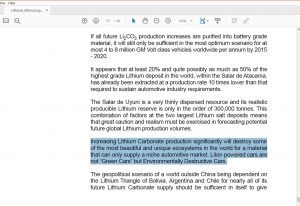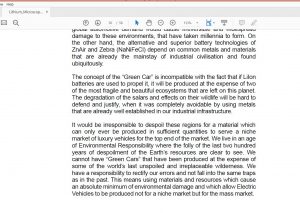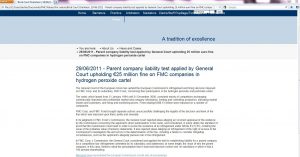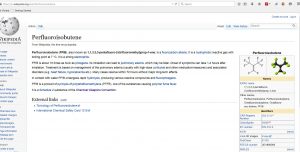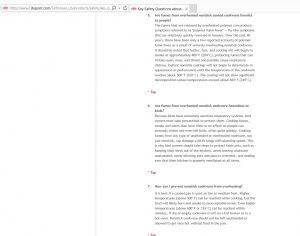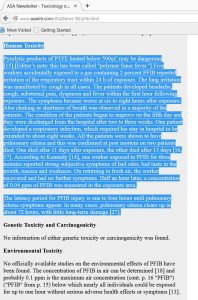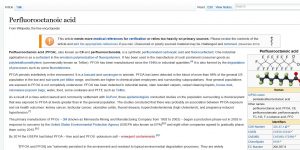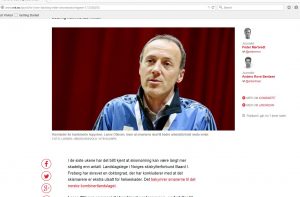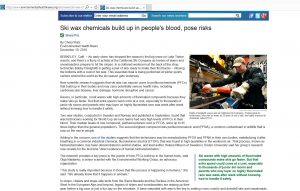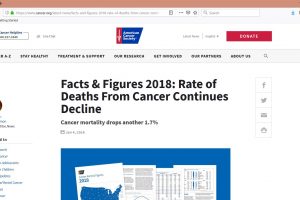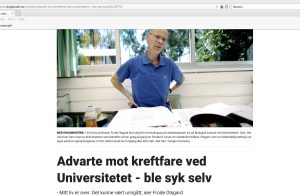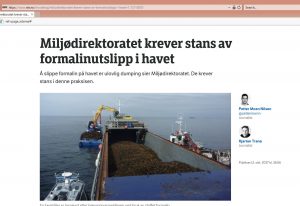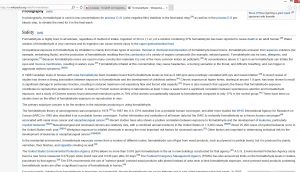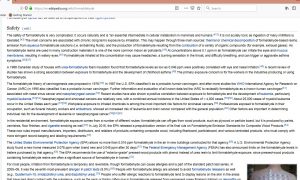In the film Is Seaweed Trawling Sustainable the documents and references are numbered.
Here are the links and information to the reference numbers in the film.
No 1)
Our page on Netalgae.
The company is funded by the eu 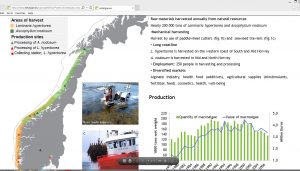
This map shows the areas mechanically harvested on the Norwegian coast.
Netalgae has produced valuable reports on the industry in the major European countries involved.
The Regulation of Seaweed Farming in the UK
Norwegian_seaweed_industry_WP12
NETALGAE_WP1-2(bis).pdf France, Portugal
Net algae promotes itself as assisting communities harvesting algae from the sea – unfortunately this also includes large scale mechanical harvesting.
It also says that it can help the industry where it is affected by local government and environment issues.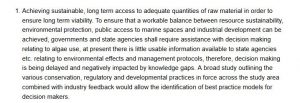
Reading the above it sounds reasonable – but if you consider it is based on the premise that mechanical seaweed harvesting is sustainable it changes into something else.
Our information leads us to believe that mechanical seaweed harvesting is not sustainable –
We made some inquiries to net algae concerning this and received no reply
We made enquiries to the EU – and were sent on a wild goose chase.
– for the EU to support this is contrary to much of what the EU stands for concerning the environment.
The EU is a signatory to the OSPAR Convention – by funding this organization it may be breaking that agreement.
https://en.wikipedia.org/wiki/OSPAR_Convention
We note that Netalgae.eu on the internet is now something else entirely. Net algae seems to have disappeared.
Where the former homepage was is now a blog in German
Irish involvement of Netalgae
This is some of the work of Mairtain Walsh from BIM the company trying to get permission for mechanical kelp harvesting on the Irish coast. Netalgae has been much involved with seaweed harvesting on the Irish coast and with the issuing of grants .
https://www.slideshare.net/EmerTaaffe/mairtin-walsh-seaweed-presentation
From this it seems they believe are no environmental or ecological issues with any form of seaweed harvesting. If that was the case why have there been so many objections to this plan both from ordinary protestors, business and professionals.
No2)
https://www.fiskeridir.no/English/About-the-directorate
These are snips from the Fiskeriedirektoratets home page showing maps of the seaweed trawling zones on the Norwegian coast.
Map showing overview of harvesting zones
from our area
Each zone is about 20 sq km and is harvested for a year – that means they can scrape the seaweed bed continuously for the entire year if they so wish.
There is supposed to be a 4 to 5 year period between the harvesting years on each zone but we note that they can harvest every third year in some areas.
Check paragraph 2 the one in blue
this is what Harald Bredahl for fmc says about their harvesting frequency
https://kart.fiskeridir.no/fiskeri
The above link is to the maps provided by the Fiskeriedirektoratet ref seaweed trawling zones and other fisheries activities.
No 3)
259148-kongelig_resolusjon_om_taretraling1
This document mentions 97 bird reserves in the 3 counties sogn og fjordane, Hordaland and Rogaland that are open for seaweed trawling –
The snip below is about concern for birds – it is part of section 5
entitled saksbehandling.
It says it is difficult to be sure about the effects of seaweed trawling on seabirds
but it is clear that some birds are dependent on the seaweed forests for food , that disturbances in the forests can effect foraging activities.
In connection with a local reduction of food seaweed trawling will disturb hatching , overwintering and roosting seabirds – this specially effects diving birds which live in big concentrations. Ref 472 nina niku.
We have other articles ref seabirds and seaweed trawling
Multi-Trophic_Consequences_of_Kelp_Harvest
No4)
This is one of a number of articles from Google on seabirds disappearing – the one we have featured in the video says that some birds have gone down by as much as 80% in the last 15 years .
This is because of lack of food – the cause is the salmon farming industries need for fish meal. They take large amounts of small fish.
(no mention of the seaweed trawling industry)
The situation is described as very dramatic.
it is interesting to note that after taretråling many small fish disappear
This research paper gives details
Here is a paper from Naturvernforbundet which expresses several concerns in relation to seaweed trawling in bird reserves, a major one of which is that above water it is strictly regulated and controlled but underwater its a very different matter. https://naturvernforbundet.no/getfile.php/1328286-1310630043/Dokumenter/h%C3%B8ringsuttalelser%20og%20brev/2005/Naturvern/planter%20og%20dyr/Kommentarer%20endring%20verneforskriftene%20vestlandet%20-%20h%C3%B8sting%20av%20tare%20i%20sj%C3%B8fuglreservater%2001.04.05.pdf
No5)
Jostein Vea a marine Biologist working for fmc/dupont who claims to have developed taretråling on the Norwegian coast says in this article that if they are not allowed to trawl in the 9 bird reserves the development of natural resources department has raised questions about then the entire Norwegian seaweed trawling industry would be in jeopardy with the loss of many jobs
.
Jostein Vea goes further to say that this has been a political decision –
that is an interesting statement as it indicates that this decision would not be made on any environmental concerns but by politicians in favor of business.
https://www.nrk.no/sognogfjordane/tarenaeringa-truga-av-forbodet-1.61239
No 6)
kelp harvest impacts summary
Independent research papers are one thing – you can rely on the information because the scientists concerned have put their signatures on the work.
But another thing entirely is government sponsored papers concerning the establishment of an industry dedicated to industrial mechanical seaweed harvesting – at the most extreme one could say they are pro the industry, but that is not the case – the papers we have read to date (ref northern Ireland, Scotland and southern Ireland) are dispassionate indeed – serious studies of the industries and its effects.
Strangely enough and sadly enough they echo the other research papers we have come across concerning environmental issues and more- thus one could hold to the idea that they are correct.
of particular interest is the summary in the Southern Irish paper
No 7)
Multi-Trophic_Consequences_of_Kelp_Harvest
We first came across this paper when we visited Runde for the seaweed trawling conference there.
Svein- Håkon Lorentsen presented his paper after which a massive row erupted with Jostein Vea telling the audience the paper was flawed and had been rejected by various august bodies – vigorously defended by Svein Hakon Louritzen – this at the open meeting.
The paper clearly shows that some species of birds do not have enough to eat after trawling and that some small fish disappear almost completely for extended periods of time.
This bears up our experience at first hand of the effects of seaweed trawling – but another interesting effect is that immediately after the trawling occurs there is an increase in fish – possibly due to the removal of the canopy and the crushing of crabs and other animals – but then after that the numbers fall off dramatically – every time the area is trawled there seems to be less small fish.
It is interesting to note that Svein – Håkon Loritsen is one of the signatures of the Irish research paper.
No 8)
At the Molde Miljøfestival 2019 we had a day dedicated to asking questions about seaweed trawling – Harald Bredahl was good enough to attend, when the issue of chemical defenses in seaweeds came up he publicly stated that “Henning Steen, one of Norway’s leading marine biologists told me that he had never heard of it, that as a major researcher he should know about it,”
It is of utmost importance to be able to verify statements – fortunately one of our activists was able to record the entire meeting – the recording is available on the net and is in our archives.
At the Trondheim taretråling meeting Henning steen as well as many other major figures in the marine biological world were present – this included representatives from many coastal councils as well as figures from the industry.
http://stopptt.com/final-day-of-the-trondheim-seaweed-harvesting-meeting/
I was given the opportunity to make a presentation – originally I had made a film but at the last moment decided to present some of the papers we had been reading, I read out a brief summary of each paper and asked those present if they knew about the issue – in every case I received a firm No, then i asked if anyone wanted to see the papers – again a very definitive NO.
it was all over in 5 minutes – I had obtained what I needed – their reaction.
Afterwards our little group was approached by a researcher wanting to see some of the papers. We were also approached by a representative from a large company wishing to become involved in the seaweed industry – he received a thick file.
no9)
Chemical defenses in seaweeds.
Reading the Irish research paper it clearly states that the damaged plants release poisons for up to 6 months after being damaged.
What effect this has we cannot say – however nearly all land plants have one form of chemical defense or another – some are extremely potent.
There are many papers on the chemical defenses of seaweeds – some are very potent too – others tell of signals being sent from one plant to another so chemical defenses are started there as well – thus it is possible that one zone of damaged plants could effect other areas thus forming a chain reaction as the majority of the coast is harvested.
Please note the use of the word possible.
Links to pdf documents ref chem defenses.
Seasonal variation of polyphenolics in Ascophyllum nodosum Phaeophyceae
2000_meps_003 chemical defences
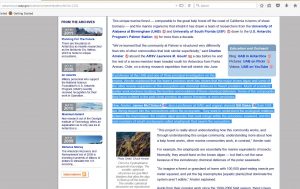 This is a fascinating snip from an expedition to the arctic and clearly poisonous seaweeds
This is a fascinating snip from an expedition to the arctic and clearly poisonous seaweeds
However it is not a serious scientific paper it is a press article
However these are as are the links above.
we have a great many more
reading between the lines it seems that researching chemical defenses in seaweed plants is a difficult subject and while there are many independent organizations researching seaweeds it seems that fmc sponsors a great many , does this effect what subjects are researched and the outcomes?
What are the penalties for publishing misleading information?
As seaweed is and has been used as a major source for iodine, iodine being poisonous it is more than likely that there is a considerable increase of this in areas where there are crushed plants – what effect this has on marine organisms is unclear
This is what Harald Bredahl from fmc says about defense chemicals in seaweeds
(“when laminaria grows again after trawling which may take 4 or 5 years or more there is a defense against all these small boring creatures extending their return from 6 to 9 years . Seaweed sends out chemical signals that means that the animals do not return to their former homes and that they have few places to hide from mackerel.” This is incorrect there are none of Norway’s foremost researchers that confirm that these chemical defenses exist.
They can therefore confirm that there is a mass of small fish around the smaller laminaria plants.)
This is quite interesting as this is a major issue – if the plants do have chemical defenses and they do prevent SOME animals and plants returning to their former status til after more years than the harvesting frequency allows then there would be a major effect on marine life, something which could be used against the industry.
This from Harald Bredahl is in response to an article in the Møre and Romsdal Budstikka one of our collaborators wrote – indeed Harald has a point, the article indicates that the chemical defenses (if there are any) prevent animals and fish from returning – we know that most of the animals and plants return but some take between 5 and 9 years to return (depending on which scientific paper you read but the consensus is there) indicating that there is something preventing them from returning.
It is more than likely that laminaria has serious defenses against predators of one kind or another(like all plants and animals) with chemical being the most likely – to be accurate we should stress that we are not qualified marine biologists we simply read reports and papers, report on their contents and occasionally when we feel the need we come to conclusions we feel are the most likely.
If these conclusions are against the interests of major corporations trawling our seaweed beds then that is something our politicians and readers should investigate for themselves. Hopefully the information we provide will be of use.
The fact is that many research papers point to the incomplete restoration of the animal and plant life in the seaweed beds after trawling
This is from Netalgae – the eu company concerned with promoting all forms of seaweed harvesting. The document concerned is a study of harvesting on the Norwegian coast.
If you consider that most of the marine life is relatively short lived and mobile why does it take so long to regrow/recolonize?
If the area is trawled every 4 to 5th year it never reaches the 7th as mentioned in the document above.
This is from an independent Norwegian research institution
the full document 5150_200dpi
restoration takes longer than the 4 to 5 years allowed by the industry what is the connection with chemical defenses?
Release of toxins by damaged plants for up to 6 months after trawling may or may not be chemical defenses but it would have an effect, especially when spread over such a large area that harvesting covers, the Irish paper which this is from also states that this effects the growth of spores – we know some areas have little regrowth after trawling.
We can only conclude from the news article on the possible sanction of trawling in 9 registered bird colonies that seaweed trawling on the Norwegian coast is regulated by politics, not science.
This little article on the surface is amusing –
seaweed can effect the weather.http://www.scitizen.com/biodiversity/the-antioxidant-function-of-iodide-in-kelp-impacts-coastal-climate_a-22-2041.html
Essentially it says that when seaweed, in this case laminaria hyperborea is stressed (under attack) it releases iodine which in the atmosphere can form fog, but the paper also goes on to say that it is also released into the water in large amounts – thus i think clearly defining a chemical defense weapon in seaweed which if the Irish paper is correct is released in large amounts for up to 6 months by damaged plants.
No clearer evidence of chemical defenses in seaweeds – in particular this one laminaria hyperborea is required.
no 10)
Reduced growth of laminaria having serious consequences for coastal communities and wildlife. (Henning Steen)
This is from an article on the havsforskningsinstitut home page
This article seems to have disappeared – formerly it could be reached by a link on the fmc/dupont homepage.
link to homepage https://www.stortare.no/ – the dupont/fmc site.
Information on home page fmc/dupont ref environmental effects
https://www.stortare.no/miljo.html
It is interesting to note that accreditation of a scientific paper is how we know that the information is correct, so it should be signed by a researcher staking his or her reputation on that fact – none of the articles on the fmc homepage are signed and the only link to a signed document we could find on this page seems to have stopped working – this is the Henning Steen document saying that damage to the forests could have serious economical and environmental consequences.
no11)
https://www.fiskeridir.no/Yrkesfiske/Areal-og-miljoe/Tarehoesting
There are many facts and figures on the internet concerning laminaria – many of them don’t quite agree so we have chosen one we feel we can rely on and that is from the organization regulating fishing of every kind on the Norwegian coast – the fiskeriedirektoratet.
From the above document we have included a little snip
It stresses how important seaweed is to the ecology and wellbeing of the coast.
That the seaweed beds cover approximately 10,000 sq km and that they are a major factor in cleaning the waters from dangerous pollutants mainly from Norway’s Industries.
It is interesting to note that the salmon farming industries have used vast amounts of hydrogen peroxide in the last few years
After use it is dumped into the sea – often in areas used by the shrimping industries destroying that industry and causing considerable economic hardships. (it is after all used to kill fish lice who are crustaceans so why should it not affect shrimps who are also crustaceans) – indeed fmc is a major player in the production of hydrogen peroxide having received a fine of some 20 million euros for interfering in the sale of the chemical
https://www.law360.com/cases/4d3ab7ad5002d1104c00000a/articles
Hydrogen peroxide is very acidic – it is sometimes difficult to find reliable information on the internet – clearly there have been attempts at removing or altering possibly sensitive articles however information we trust puts the ph of hydrogen peroxide at between 1.2 and 5 – as it is made mostly made using sulphuric acid(ph 1) its ph is not surprising but it effects on the marine environment are.
Its effects on the ecosystem and animals have been kept hidden for many years
It kills seaweed for a start – this information came out because attempts at growing seaweed near to salmon farms failed – the culprit was soon found to be the chemical used by the industry to control sea lice – hydrogen peroxide
The industry apologizes for misleading information
http://oppdretsnæringa beklager feil informajson om lusemiddel
NO 12) The local seaweed deppo
http://www.kommunenvar.no/?div_id=54&pag_id=55&art_id=1180
The website proudly announces they take in about 50,000 tons per year.
If you consider the snip from the Irish state paper that figure should take into consideration that for every stalk harvested 2 are left destroyed – so to be correct that figure should include another 100,000 tons left destroyed on the seafloor.
Satellite map of seaweed deppo
No 13)
Northern Ireland feasibility study of the seaweed harvesting industry.
seaweedharvestingniehspositionstatement
This paper is produced by the northern Ireland environment and heritage service.
https://www.gov.uk/government/organisations/environment-and-heritage-service
We have contacted the service ref this paper and spoken to the authors and are very secure in the belief that this is a completely neutral study of the industry.
It clearly reinforces our belief that mechanical seaweed harvesting is not sustainable, here are the relevant snips from the above document
Page 10 ref harvesting methods.
No 14)
This is another feasibility study of the seaweed harvesting possibilities in southern Ireland produced by and for the government of that land.
When a paper has the signature of its author it is verification that the author to the best of his or her abilities has declared that the information contained is true. Thus they have staked their reputation and their career on this.
This has the signature of 45 researchers from many countries including 7 from Norway.
It makes a number of statements that could have serious impacts on the seaweed trawling industry.
Here it says that 2 plants are broken for every 1 harvested – Assuming that the “broken” plants die then that clearly states that twice as much is destroyed as is harvested add that together then the harvest should read 3 times more than is declared – thus the Norwegian harvest is 200,000 tons plus “for the 2 plants left broken for every one harvested ” 400,000 tons making that a total of 600,000 tons annual harvest on the Norwegian coast.
Toxins released by dying plants.
This particular reference refers to laminaria digitata, however there is no reason why this cannot apply to lam hyper too.
(page 54)
This from the above document states that the crushed and dying plants release toxins for up to 6 months after the damage – as previously stated 400,000 tons of damaged laminaria plants releasing toxins is something that should be taken seriously – yes the paper does not have any information on the type of toxin however laminaria has been used as a source of Iodine and other substances – iodine is a serious poison.
For further information ref chem defences see No9)
Norwegian reports biased.
The industry is keen to promote every aspect of its work as beneficial – thus it is easy to find unsigned information and or altered wiki articles substantiating this. Fmc/dupont is also a major contributor to financing research – it is easy to assume that negative results would not be desirable – we have observed the effects. Fortunately there are a number of marine research institutions in Norway that do not seem to be affected by this yet, so there is plenty of information available ref the negative consequences of seaweed trawling.
This document is written by many experts and specialists, their combined knowledge and expertise is clearly shown with valuable references to further reading. 00510620
The authors
There is currently an attempt to introduce kelp harvesting by mechanical means on the Irish coast – the target area Bantry Bay.
This aroused a huge public outcry with several Irish mps making statements in the doyle.
A very active protest group with over 25,000 signatures – many protest marches and serious questions being asked as to the interest of the Irish government in maintaining a ecologically sound marine environment.
Facebook link https://www.facebook.com/bantrynativekelpforest/
no 15)
00510620 Wild seaweed harvesting in Scotland report.
This is a feasibility study on the possible industry – state produced
we wrote a report on this some time ago
https://stopptt.com/scottish-seaweed-harvesting/
It is a very pretty report but has some discrepancies
There has been an attempt by the Scottish government to start seaweed trawling on the Scottish coast – this was met by a massive response against the initiative – some 30,000 protest signatures plus over 150 small industries involved with the Scottish seaweed industry protesting
SE_LINK_Response_Marine-Biopolymers-Scoping-Report_2018
LINK is concerned that the approval of this proposal would open the door for other companies to begin harvesting kelp and for this industry to expand rapidly, without adequate controls and without a full understanding of the broader ecological consequences of kelp removal. Without a detailed understanding of the distribution, density, health, and recovery rate of Scotland’s kelp habitats it is not possible to identify sustainable rates of harvesting.
Before applications for large-scale, commercial seaweed harvesting can be considered, it is vital that the Scottish Government develops a seaweed management plan that ensures any large-scale removal of seaweed is carried out sustainably and will not have a long-term, detrimental impact on the marine environment. The management plan should identify small areas where seaweed harvesting can be trialled, with robust mitigation and monitoring measures, but leave the majority of seaweed habitat untouched, which can be used as control sites for future studies to assess the environmental impact of seaweed harvesting.
This seems a very sensible approach – so why was it not implemented before the request to initiate seaweed trawling was set in motion – several possible answers.
The facebook site for the protest group
Finally Sir David Attenborough became involved with the issue
first a letter to the times
Then articles
https://www.archynety.com/tech/sir-david-attenboroughs-bid-to-save-scottish-kelp/
Several Scottish politicians spoke out against the seaweed trawling but we note that the company concerned was told to try again at some future date.
The original report has several glaring anomalies – including no mention of the use of formalin, a declaration that to maintain the biomass in the forests the roots are going to be cut off the plants and replaced – fascinating.
Just to be clear formalin has to be used (many other chemicals have been tried) to stop the plants from releasing hydrogen sulphide when they start to decay which is almost immediately they are taken from the water – to harvest the amounts mentioned here they would certainly need the chemical – it is listed as a grade 1b cancer risk – that is you are very likely to get cancer (5 different types) if you are exposed to it for any length of time.
no16)
Rinde et al. 2006 – Effekter av taretråling
This paper is produced by Nina
https://nina.no/
They seem to be completely independent of any major connections to industries involved with exploitation of our nature.
Unlike the Havsforskningsinstitut.
The front page of the report
The information that is of particular interest to us is this
Essentially it identifies the amount of regrowth laminaria hyperborea produces per m/2 and harvesting frequencies and does the math which identifies 85/km/2 as the area needed to produce the 200,000 odd tons the Norwegian seaweed harvesting industry says it harvests per year – if every condition was perfect.
The area would be divided into 20sq km strips as it is in the “wild” which would each be harvested on a 5 year rotational basis.
It is interesting to note that the paper identifies that the conditions are never perfect so much more would be needed anyway but why so much?
In fact over 100 times more is harvested making it clear that something is seriously wrong – why would the company concerned be so keen to harvest in sensitive areas such as bird reserves if they did not have to?
Surely the negative publicity would be bad for business?
No17)
This is in reference to Harald Bredahl https://www.stortare.no/kontakt/vormedal.html
Here is our film of his performance at the Clima festival in Molde jan 2018
https://www.youtube.com/watch?v=8CfXHAt7TCk
Ably filmed by one of us
He demonstrates how much seaweed there is on the Norwegian coast by dividing it up into squares – the red squares are the amount that is torn loose by storms and other actions – the green squares represent the amount fmc/dupont takes per year – Harald Bredahl adds the green squares to the red squares rather than leaving them separate – presumably indicating that it is so little that it could easily be accepted as a natural loss however we say that is wrong because the plants are not naturally torn up by a mechanical trawl nor crushed and left producing poisons (ref Irish paper) the paper also says that for every plant torn up, 2 are left damaged, thus the green squares should be 3 times larger than represented.
This is another attempt by the industry to try to minimize the impact its activities have on our ecology.
our report on the 2018 seaweed trawling debate as part of the 112 clima festival in Molde http://stopptt.com/lecture-and-debate-on-seaweed-trawling-molde-klimafestival-jan-2018/
No 18)
From the West Highland free press – an article from the company wanting to start commercial seaweed trawling on the Scottish coast.
This came out after a campaign against the introduction of the industry was vastly successful.
This snip is important for us as it shows how the big firms involved want the governing bodies to think.
Here is the relevant piece from the above
This is fascinating as it says we dont know what we are talking about – that they do. That they use the best scientists and marine experts .
That sustainability is at the heart of everything they do and that the harvesting method they want to use has been successfully used in Norway for over 50 years.
It is interesting to note that they have not produced any information from scientific papers(that we have seen) confirming the sustainability of the industry – so far, but we have.
You can follow our information back to its source and find out for yourself.
We would seriously like to be wrong about the environmental and ecological issues but nothing we can find verify shows this – only opinion pieces.
our short film at the 2018 seaweed trawling debate in Molde (part of the 112 clima festival)
https://www.youtube.com/watch?v=29yYN4Cggr8
At the event in 2019 there was more time for debate –
Magnus Tornes identified himself as a marine biologist and made the following statement concerning our new film
“this is the most hair raising i have ever heard – there is a complete lack of understanding”
https://www.youtube.com/watch?v=qtzNndaLycs
it is possible that this is more to do with someone daring to stand up against the interests of big business and using the words used in scientific reports (which is very difficult for anyone to contradict) than it is to do with facts.
The words used in any report are the same words we all use, they have the same meaning for scientists as they do for everyone.
There is a very definite hierarchy in the scientific world, the word of senior researchers is not questioned, this is why we are at a distinct advantage – we have no qualifications, no career which could be damaged by standing up to bullying, but we do know that our publications are carefully read.
We are often contacted by major companies, regulating bodies, students and other organizations seeking information, we do our best to comply.
No19/20)
The Morals of Big companies and corporations.
The desire to compete is something that is induced at a very early age, for some this goes beyond reason and morality. This is possibly why there is a possible connection between successful businessmen and psychiatric abnormalities.
The question of your product causing death and tremendous suffering has long been a historical record with few consequences – the tobacco industry covering up scientific results clearly showing it is a major cause of cancer – you can still buy tobacco in every country in the world and the fact that people still smoke shows they have not considered the implications seriously enough – not me seems to be the key.
https://www.cancer.gov/about-cancer/causes-prevention/risk/tobacco
– in the early part of the 19centuary a company called undark convinced its employees to decorate the dials of watches and other instruments with radioactive paint – they were encouraged to lick the brushes covered with paint to a point – net result – every single one died the most agonizing death from radiation poisoning
https://www.damninteresting.com/undark-and-the-radium-girls/
The 2 corporations concerned with seaweed trawling on the Norwegian coast
have some of the most dismal records of any.
Dupont https://www.dupont.com/
Their “corporate” faces.
Fmc corp is composed of well over 200 companies with many and varied interests, but most are involved with the exploitation of natural resources and many have been found guilty and received world record fines for pollution of nearly every kind. Others have received fines for illegal business practices such as price fixing cartels or even downright fraud.
Their agricultural chemistry branch produces a chemical called Carborufan or alternatively known as furadan, they say it is essential for controlling pests – unfortunately it is also eaten by birds and mammals – it kills with an agonizing death – because of this it has been used to kill large predators such as lions, this has now been recognized and there are some attempts at control but for many years this chemical was available for very little over the counter in African stores
https://www.youtube.com/watch?v=Jf7m2kSU94o
Reaction to concentrated protests have led to a ban – however if the company was responsible then this would not have been necessary – if companies/corporations who are trusted with research never lied or twisted the results the world would be a much healthier place, good for business.
Fmc is also involved with the extraction of Lithium from the Atacama – this is one of the driest environments on earth and is consequently also one of the most fragile ecosystems on our planet – information concerning the ecological damage is available on the net
these are just a few of the issues with fmcs exploitation of the natural world.
It seems the old philosophy of – if it is damaged we can pay for it still exists – it is clear that money will not compensate for the losses that nature has suffered, nor will it compensate for the ultimate loss to humanity and thereby our suffering.
Fmc has also a few issues in the business world
https://www.sfgate.com/news/article/125-Million-Verdict-in-Bradley-Fighting-Vehicle-3008988.php
direct fraud
The big question is should any company/corporation be allowed to continue if it is clear that it has a habit of misleading?
We trust not only our nature to these people but ultimately our wellbeing and our lives, do they deserve that trust?
DUPONT.
https://tv.nrk.no/program/KOID21007018/et-giftig-industrieventyr
This focuses on the issues from the production of Teflon and how the company behaved –
This is what they say about seaweed.
https://www.dupontnutritionandbiosciences.com/sustainability/world-oceans-day.html
In reference to undark and other lethal industries the major product from dupont was Teflon –
Domestically it is in nearly every household in the form of coating on cookware and other items subjected to heat.
It is clear that the product is flawed and should never have been allowed on the market because when it reaches the temperature of 220c it starts to release dangerous substances among which is a gas called
PERFLEUROISOBUTENE
This gas is so poisonous it is in section 2 of the chemical weapons register. The reason why there are no household deaths associated with the substance is that the layer of Teflon on the average pan is so thin that there is simply not enough to do more than make one ill with flu like symptoms – this is what duponts homepage says – or said
Yes there is enough on a frying pan to kill household birds but not enough for humans though there are a number of recorded deaths associated with the chemical
The public and the state are still mislead over the dangers of ptfe (Teflon) by clever use of the substance used in the manufacture of Teflon, pfoa
By owning up to its carcinogenic and mutagenic nature the attention of the media is drawn to this and they look no further – endless articles on Teflon and du pont only focus on this, not on the real issue TEFLON should never have been used on domestic cookware.
Though there is not enough teflon on a frying pan to kill of it gets too hot, there is more than enough in a spray can of ptfe (Teflon) produced by many companies worldwide.
Contact with state run health and safety organizations, with independent press, both state and private have produced a deafening silence though they admit the information is correct –
No 21)
As stated above – Teflon produced by the company now controlling seaweed trawling on the Norwegian coast is a dangerous product and should never have been allowed for domestic use, certainly not with food.
Ski wax is usually applied using heat – this has made many people sick – Norwegian broadcasting NRK produced a series of articles on this issue.
It is interesting to note that there seems to be no mention of perfleuroisobutene –
No 22)
https://www.foxnews.com/story/rotting-seaweed-on-french-beaches-releasing-potentially-deadly-fumes
https://www.theaustralian.com.au/news/world/killer-seaweed-clears-french-beaches/news-story/d7bf98c79706bff723c771892904a243
This problem is not just restricted to the species of seaweed found on the French coast but also the channel islands and the UK coast – further this is the same with nearly all seaweeds. The Norwegian seaweed trawling industry is particularly affected as it has to store very large amounts – often several thousand tons at a time.
The gas released by the rotting plants is particularly lethal in enclosed spaces
No 23)
Formalin is used by the seaweed trawling industry to prevent the release of lethal hydrogen sulphide gas from decomposing seaweed plants.
Formalin has been much used for disinfection, storage of scientific specimens, and far more.
Because of its “passive” nature it has not been regarded as especially dangerous, however its real nature became evident in the early 70s and as a result it was banned in all schools and museums as a preservative – it causes cancers – at least 5 different types are associated with this chemical.
Some exposed workers can be safe for many years then develop the cancers – others take a much shorter time, as a result it has been classed as a 1b2 cancer causing substance – that means you will probably develop cancer if you work with it.
With a figure of near 1 in 3 contracting cancer in their lifetime it is essential that anything which can cause cancer is taken seriously by society and not regulated by the needs of large companies. The costs of caring for cancer patients by far outweighs the financial gains of society from any industrial activity, thus we are all paying financially for the gain of a few individuals.
From the american cancer society
The man in the article below is a professor who worked on seaweed samples for many years before developing lung cancer – he was informed by his employers that formalin was so harmless you could drink it – they refused to install proper ventilation systems in his work place. His illness and the cause has now been officially confirmed – yes he got cancer from Formalin.
https://www.dagbladet.no/nyheter/advarte-mot-kreftfare-ved-universitetet—ble-syk-selv/65239770
It is the only chemical that has been proven to be effective against the production of hydrogen sulphide by rotting seaweed plants.
It is used extensively in the Norwegian seaweed trawling industry though the industry itself says it uses little.
After use the chemical is dumped into the sea
This boat Bona Sea is one of 3 carriers for seaweed on the Norwegian coast – it was stopped by the miljødirektoratet https://tema.miljodirektoratet.no/en/
and researches carried out – it was found to have used – and dumped 24,500 liters of formalin in 9 days – further the industry uses 800,000 liters a year.
https://www.nrk.no/trondelag/miljodirektoratet-krever-stans-av-formalinutslipp-i-havet-1.13715810
it is interesting to note that the article says “illegal dumping” and yet it still goes on.
We know of a compensation case in Kristiansund in the 90s where all the workers in a seaweed deppo became sick, most with cancer but unfortunately we cannot find any official details. This is confirmed from several sources.
The seaweed deppo at Smørholm has a large tank of formalin on an exposed rock, the pipework is in the air – the sign confirming the contents is too small to be read at any distance, there are no warning signs – none of the workers we have observed wear any protective gear and the weed covered with formalin is exposed to the air as it is dumped from an open conveyor into the cargo hold of the transport ships. The equivalent of waving a cloth soaked in formalin in the air.
https://www.youtube.com/watch?v=Z1m1-JnqWEI&feature=youtu.be
There are many families in the area with new houses currently being built.
The dangers of formalin have been strongly played down by employers, with several actively seeking to influence the public as to its apparently lack of dangers
it is interesting to see how the Wikipedia article on formalin has been changed over the last 5 years
While the significance of the article remains unaltered for those who scan read, it has changed significantly, from 30 ml being enough to kill one it now reads
“it is not acutely toxic as many milliliters are required to kill you”
from “Formalin is highly toxic to all animals regardless of method of intake”
to “It occurs naturally and is an essential intermediate for cellular metabolism in mammals and humans”
